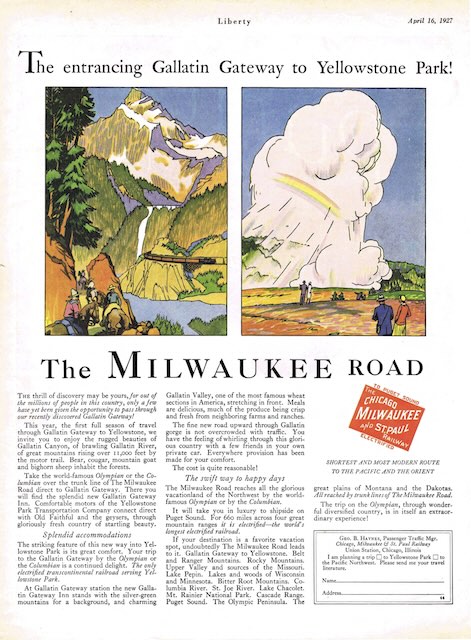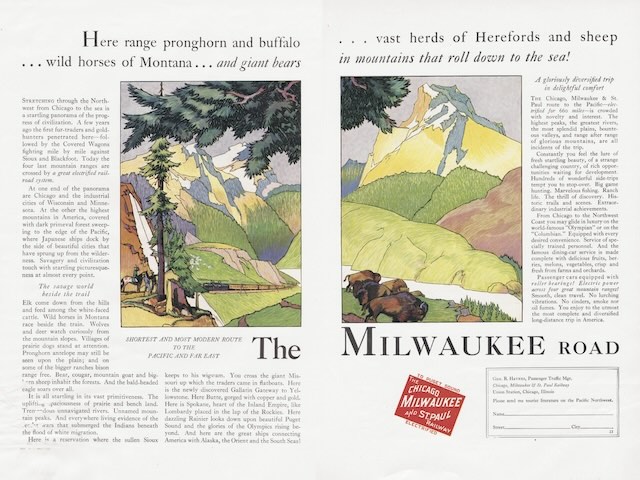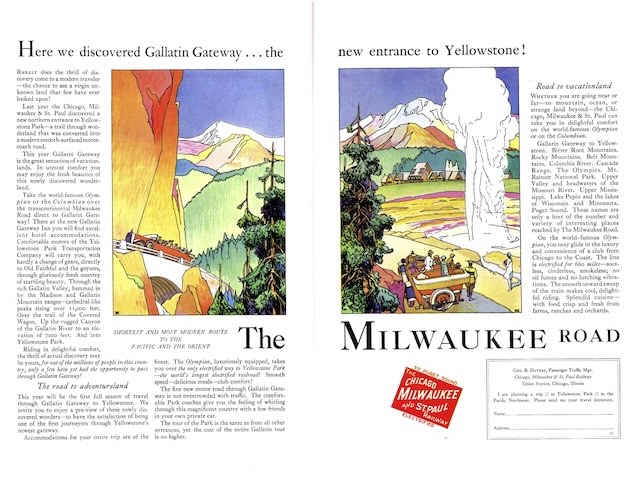1927 was an auspicious year for the Chicago, Milwaukee and St. Paul Railroad. On June 18, it opened the Gallatin Gateway Inn, its entrance into Yellowstone National Park. In August, it began operating the new Olympian, a completely new train and the first train to the West Coast equipped with roller bearings.
 Click any image to download a 12.7-MB PDF of this collection of 16 advertisements.
Click any image to download a 12.7-MB PDF of this collection of 16 advertisements.
Most importantly, it was emerging from bankruptcy, having entered receivership in 1925 due to its inability to pay off bonds sold to construct its Pacific Coast extension. Although revenues had been well above the company’s operating costs, it had a massive debt due to that construction costing four times as much as anticipated. Because of the Great War and the opening of the Panama Canal, among other factors, revenues were simply not sufficient to pay off the debt, so when $48 million worth of bonds became due in 1925, it defaulted.
At the time, it was the largest bankruptcy in U.S. history, and after adjusting for inflation it remained so until the PennCentral bankruptcy of 1970. (Today, after adjusting for inflation, PennCentral wouldn’t even be in the top ten and the St. Paul wouldn’t be in the top twenty.) But the company also emerged rather quickly as most of the bondholders agreed to a settlement that gave them part ownership of the new company.
In November, 1926, the railroad’s assets, which in 1925 had been assessed at $668 million, were sold at auction — there was only one bidder — in Butte, Montana for $140 million. The new company was initially to be known as the Chicago, Milwaukee and Pacific Railroad, and it would have formally emerged from bankruptcy in 1927 except a few minority bondholders held it up in court until early 1928.
As a part of its recovery, the company wanted to distinguish itself from its predecessor. While many members of the public informally called the railroad “the Milwaukee,” in financial and railroading circles it was known as “the St. Paul.”
To avoid any taint associated with that name, the new railroad conducted an extensive advertising campaign in 1927 proclaiming itself to be “the Milwaukee Road.” “The sad associations of the old St. Paul securities will tend to be lost sight of as everybody writes, talks, and thinks ‘Milwaukee’ instead of ‘St. Paul,’ with reference to the new securities,” commented Literary Digest approvingly. This is also why St. Paul was initially left out of the name of the new company.
Historian Michael Sol has collected 15 double-page ads and one full-page ad associated with that campaign. I’ve assembled them into one PDF. Note that the ads still say, in fine print, “Chicago, Milwaukee and St. Paul Railway” as the new name would not be formalized (as Chicago, Milwaukee, St. Paul and Pacific) until 1928.
Three of the ads were in color, while the other 13 were in black and white. The PDF has the color ads first and then the black-and-white ads in the order in which they appeared in various magazines. Based on the size of Mr. Sol’s images, most of these magazines were either 8″x12″ or 10″x14″ in size, and I’ve tried to present them in those sizes.
The signature on the illustrations in these ads is just an “H,” which Mr. Sol says stood for Peter Helck (1893-1988). A native of Manhattan, Helck began drawing steam locomotives that he saw near Grand Central Station at the age of 5. He was particularly inspired by the Vanderbilt Cup Race of 1906 to go to art school. His favorite subject was race cars and he has been called the dean of American automotive illustrators.” But Helck painted many other forms of transportation, including trucks, ships, planes, and of course trains.


